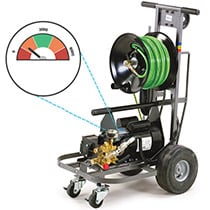Basic troubleshooting can help solve some of the pressure issues that can afflict any jetter from time to time: low pressure, loss of pressure, or pressure spikes. These issues can be caused by a few different things, most of which have simple fixes. When something seems amiss with your jetter, here are three steps to start your diagnosis:
First Steps
- Check the nozzle. Any nozzle that is clogged or in need of repair will have an effect on pressure
 and volume. For drilled nozzles, use a nozzle cleaning tool to clean out its orifices, staying aware of the angles of the jet openings. For nozzles with inserts, follow the manufacturer’s recommendations for checking the nozzle. You may need to check rotation as well as the inserts. Be sure the nozzle is sized correctly for the jetter’s pump. Using a nozzle that is either too large or too small can adversely affect pressure. Once you’ve checked and cleaned or repaired the nozzle, reattach and power up the system to see if that solved the problem.
and volume. For drilled nozzles, use a nozzle cleaning tool to clean out its orifices, staying aware of the angles of the jet openings. For nozzles with inserts, follow the manufacturer’s recommendations for checking the nozzle. You may need to check rotation as well as the inserts. Be sure the nozzle is sized correctly for the jetter’s pump. Using a nozzle that is either too large or too small can adversely affect pressure. Once you’ve checked and cleaned or repaired the nozzle, reattach and power up the system to see if that solved the problem. - Check the water supply (if possible). Jetter pumps require a certain flow rate for supply water in order to function properly. Check your owner's manual to find the gallons-per-minute (gpm) capacity for your model. To test the supply, run a hose from the water source into a 5- or 10-gallon bucket for 1 minute. If the number of gallons in the bucket after 1-minute falls short of the required gpm rating, then your jetter is not receiving enough water from the source. This will adversely affect its spray pressure.
- Test the water supply through the jetter. If your nozzle is clear and the supply is sufficient, then test the flow through the jetter hose. Perform the 1-minute bucket test again using the jetter hose without a nozzle attached. If the jetter is still producing the appropriate gpm, other issues could be the problem.
Looking Further
If those steps don’t give enough insight, you may need to dig deeper.
A leaking jumper hose, or the ball valve that connects the jumper hose to the high-pressure hose could be the culprit. Inspect those.
Know the size and length of hose that is optimal for the jetter to perform correctly. The longer the hose, the lower the pressure at the nozzle. Be sure to follow both the jetter and nozzle manufacturer’s recommendations for hoses.
Finally, the issue could be in the pump itself. New noises or milky/cloudy oil in the pump could indicate a cracked ceramic plunger or bad seals. Other problems in the pump can cause drops in pressure and performance as well.
MyTana backs all our equipment with factory-direct support. Request our catalog to learn more about our family of jetters.



